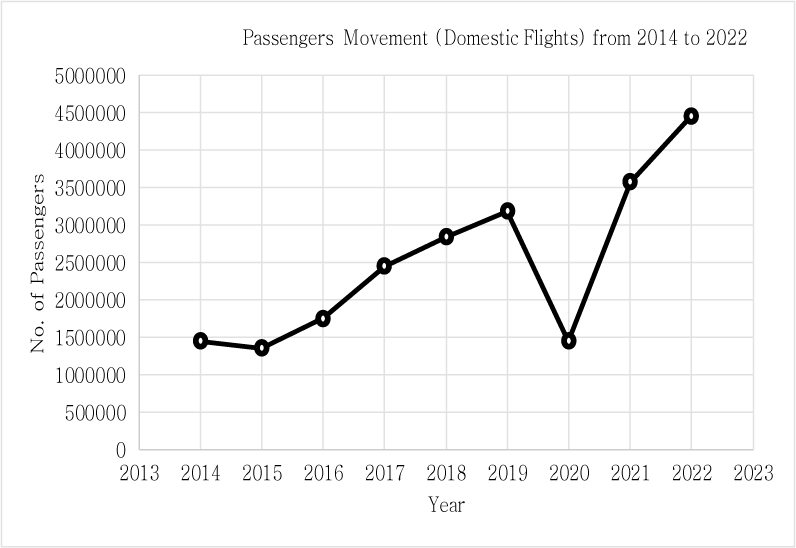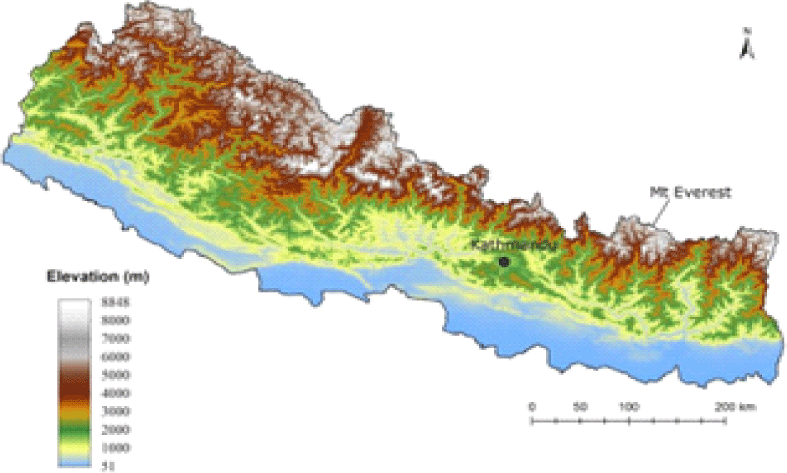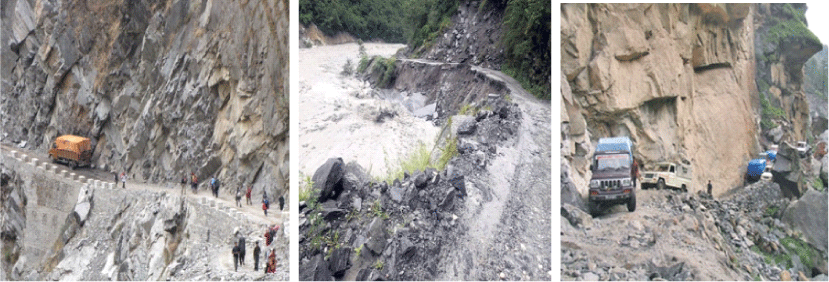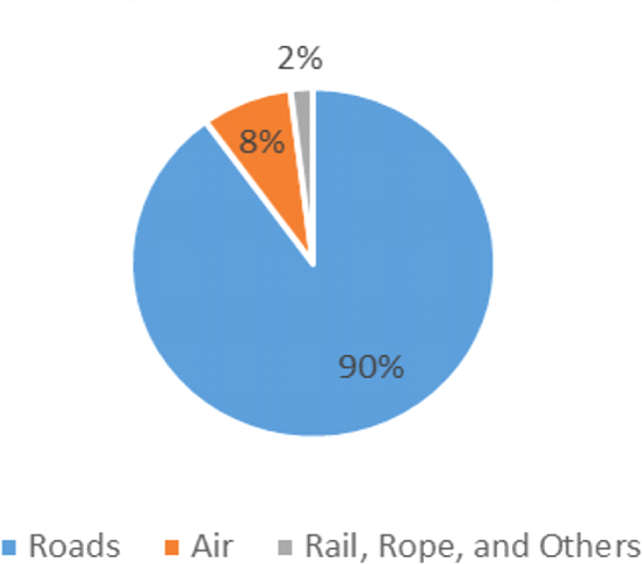I. Introduction
Nepal is a country with a lot of mountains and the majestic Himalayas. It has beautiful scenery that includes rocky peaks, valleys, meandering rivers, and rugged landscapes. Although these natural features add to Nepal’s attraction, they also pose significant barriers to developing infrastructure and transportation. The terrain is varied, ranging from low-lying plains to the tall Himalayan summits. Because of the sudden elevation changes over short distances, from 50 meters above sea level to the towering height of 8,848 meters, there are major transportation challenges indicated by several literature. Furthermore, the country’s rough terrain combined with natural phenomena like earthquakes and cyclical monsoons makes it very difficult to build and maintain transportation infrastructure in Nepal.
Nepal continues to face challenges in promoting trade and commerce, linking isolated communities, and guaranteeing access to basic services like healthcare and education, even with concentrated efforts to improve transportation infrastructure. Roads and conventional aircraft are the main modes of transportation currently in use, and both are hindered by adverse weather and have trouble navigating the mountainous terrain. The challenging topography of Nepal’s hill and mountain regions marked by rugged landscapes, intense monsoon rainfall, unstable geological conditions, and steep slopes deviates transportation connectivity considerably (Pande, 2017).
The inadequacy of efficient road infrastructure alongside the scarcity of alternative routes amplifies the difficulties associated with transportation in Nepal, leading to increased expenditure on transportation. Rural communities bear the brunt of inadequate transportation infrastructure, facing barriers in accessing emergency aid, economic opportunities, and basic services. This disconnect exacerbates socioeconomic isolation, impedes trade and agricultural productivity, and perpetuates inequality. Pandey (2017) argues that enhancing rural infrastructure and transportation networks is crucial for poverty reduction, as it enhances economic opportunities, market access, and societal engagement in rural areas. Meanwhile, addressing existing transport and connectivity issues through innovative solutions is imperative to improve access to essential services, bolster economic sectors, and promote overall development.
This paper endeavors to delve into Nepal’s transportation challenges and evaluate the potential of Advanced Air Mobility (AAM), a recent innovation in air transport, as a viable solution. By transcending the limitations of traditional ground-based and costly air transportation infrastructure, AAM, which incorporates technologies like unmanned aerial vehicles (UAVs) and electric vertical takeoff and landing (eVTOL) aircraft, holds promise in enhancing the effectiveness, accessibility, and interconnectivity of Nepal’s transportation network.
By utilizing AAM technologies, Nepal can promote socioeconomic development and raise the living standards of its citizens. The objective of this study is to offer an understanding of the viability, consequences, and suggestions for putting AAM solutions into practice in Nepal, to address the nation’s transportation issues and clear the path for a more sustainable and accessible transportation system.
II. Nepal’s Transportation Infrastructure Status and Issues
More than 90% of goods and passenger movement in Nepal heavily relies on road transportation, while the country has the lowest road density in South Asia (Dhakal, 2022). The road network, totalling 77,025 km, constitutes a crucial lifeline, especially in rural areas, where the Provincial and local road network (PLRN) comprises 86% of the total road infrastructure. These roads, covering 31,965 km of provincial roads and 31,612 km of local roads, provide essential access to economic opportunities, healthcare, education, and relief efforts during natural disasters for nearly three-quarters of the rural population (World Bank, 2022). However, challenges persist, with only a quarter of PLRN roads offering year-round connectivity, maintenance neglect, and varied road standards posing additional hurdles.
The rugged terrain of Nepal poses substantial obstacles to both road construction and travel. Construction efforts in predominantly mountainous and hilly landscapes are arduous and time-consuming, making even paved roads risky to traverse due to winding and narrow sections, increasing the risk of accidents (Nate, 2022). These challenges significantly hinder access to services and markets, especially for farmers, limiting investment and production capabilities. According to studies conducted in rural Nepal, as travel times to markets increase, rural residents’ levels of education, income, cropping intensity, and access to non-farm employment gradually decline (World Bank, 2022).
Air services, on the other hand, have emerged as indispensable for navigating Nepal’s rugged landscapes, offering rapid transit options for valuable cargo and travellers, particularly in remote regions. Shah (2023) emphasizes the crucial role of air travel in Nepal’s tourism sector, supporting 381,000 jobs and contributing USD 807 million to the Gross Value Added (GVA). Despite the challenging terrain, air transport serves as a vital link, connecting remote areas and facilitating the movement of people and goods. Helicopter services play a vital role in Nepal’s tourism sector by granting access to remote destinations inaccessible by ground transport. Furthermore, they are crucial for addressing medical emergencies, including obstetric cases, in remote Nepal, aiding the healthcare sector significantly. According to the report of the Civil Aviation Authority of Nepal (CAAN) (2023), an increased trend has been seen in the passenger movement illustrated by Graph 1. The decline in 2019-2020 is perhaps because of the effect of COVID-19 which increased again after recovery. Insufficient and inefficient road infrastructure in Nepal has led to a growing demand for air transport, which offers advantages in terms of time and safety. Nevertheless, challenges such as high costs and limited availability impede the effectiveness of air transport in addressing transportation needs.

In Nepal, inadequate road infrastructure and limited aviation services pose significant transportation challenges. Roads are sparse, unpaved, and mostly concentrated in certain regions, while aviation services face high costs and technical hurdles, restricting their usage to select cities and remote areas. This infrastructure gap deepens the urban-rural divide, highlighting the urgency for strategic interventions to enhance road accessibility and expand air services for more inclusive connectivity across the country. Poor road conditions, old vehicles, and air pollution resulting from dust and carbon emissions add significant environmental challenges too. Travel delays are compounded by seasonal challenges. The rainy season brings muddy conditions, making roads slippery and difficult to navigate, while winter conditions of fog or snow reduce visibility, increasing the risk of accidents. These seasonal factors exacerbate existing issues of inadequate road infrastructure, highlighting the need for comprehensive planning and investment to address transportation challenges year-round.
Nepal’s rugged terrain and vast river network create significant challenges for communication and transportation, particularly in hilly regions. The mountainous terrain in addition to more than 6000 rivers in Nepal makes building and maintaining roads and infrastructure more difficult. This leads to hazardous travel conditions, especially during the monsoon season, and limits accessibility in remote areas. Nepal’s Strategic Road Network (SRN), spanning over 12,000 km with 2,000 bridges, is crucial for transportation and trade. However, it suffers from significant deterioration, as indicated by Nepal’s low ranking (120th out of 141) in road infrastructure quality in the Global Competitiveness Report 2019. Approximately 18,861 meters of SRN roads need new bridges to improve connectivity and foster economic growth, exacerbating challenges, especially during the monsoon season (The ieConnect for Impact Program, World Bank). Moreover, poorly constructed road infrastructure in Nepal’s mountainous regions exacerbates erosion and landslide risks, disrupting local hydrological patterns and destabilizing slopes. This poses serious threats to communities’ lives and livelihoods (Sudmeier-Rieux et al, 2019).
Improving rural transportation infrastructure is crucial for enhancing living standards, as rural regions contribute significantly to the national economy. However, Nepal’s unique geographic, economic, administrative, and climatic conditions present significant obstacles to infrastructure development. Steep topography, frequent landslides, and competing development priorities hamper construction and maintenance efforts. Moreover, regulatory barriers and administrative hurdles impede investments in transportation infrastructure, while weather-related events like floods and earthquakes can cause extensive damage, necessitating costly restoration and maintenance efforts. Innovative and cost-effective solutions are needed to navigate these obstacles effectively. By embracing new and advanced approaches emerging in the field of transportation, Nepal can improve connectivity, promote economic growth, and ensure long-term resilience in its transportation sector, while minimizing environmental impacts.
III. Advances in Aviation Technology and New Opportunities
Advanced Air Mobility (AAM) marks a significant advancement in the aviation industry, introducing cutting-edge technologies and operational concepts. This innovation has the potential to revolutionize global transportation by offering faster, more efficient, and environmentally friendly solutions (Autonomy Institute, 2023). AAM promises to overcome traditional transportation barriers, improve urban mobility, and reshape the way people and goods are transported worldwide. This new area of study combines advanced air traffic control systems, electric propulsion technologies, and aircraft design to create a transportation network that is more accessible, sustainable, and efficient (Access Partnership, 2023).
Classified as AAM, the new air transport service covers Urban Air Mobility (UAM) and Regional Air Mobility (RAM) for transporting passengers and cargo in urban and regional areas using “highly automated aircraft” (Federal Aviation Authority, FAA). AAM offers a wide range of innovative applications beyond traditional passenger and freight transport. These vehicles are designed to address various transportation needs, including search and rescue missions and connecting underserved communities (FAA), thereby broadening the scope of aviation services.
NASA claims that Advanced Air Mobility (AAM), which focuses on smaller aircraft that can reach rural and urban areas inaccessible to conventional airplanes, introduces a new era in air travel. Initiating this project, NASA hopes to create an automated, safe, and reasonably priced air transportation system.
The creation of AAM was a cooperative effort involving important stakeholders from several industries rather than the product of lone efforts. AAM research, development, and implementation initiatives are being driven by organizations like NASA, regulatory bodies, and industry leaders (Kiesewetter et al., 2023). This cooperative strategy emphasizes the understanding of AAM’s transformative potential and the group’s shared goal of promoting its expansion and incorporation into the current transportation networks such as Nepal where insufficient infrastructure and rough terrain impede accessibility.
The development of ‘electric propulsion vertical take-off and landing (eVTOL)’ aircraft, which do not require a runway, can be built and operated at a low cost, has been made possible through rapid development of technologies such as electric propellers and devices, batteries, materials, autonomous flying technologies, etc. In addition, these innovative aviation technologies such as eVTOL have enabled the operation of aircraft in areas where the use of aircraft was previously restricted, such as urban areas. This has enabled close connection with existing transportation systems such as roads, railroads, ports, and aviation, resulting in a new form of air transportation called ‘Advanced Air Mobility (AAM). AAM will be an innovative approach that can overcome the constraints of traditional transportation, especially for countries such as Nepal, where it was difficult to establish efficient infrastructure due to harsh geographical and environmental factors.
AAM offers a host of benefits, including reduced travel time, enhanced accessibility, and congestion relief. Electric propulsion systems utilized in eVTOL aircraft ensure minimal carbon emissions and noise pollution, making them environmentally friendly and economically viable alternatives to traditional aircraft (Hwang and Hong, 2023). Moreover, the versatility and efficiency of eVTOL aircraft make them well-suited for addressing Nepal’s unique geographical and logistical challenges. According to NASA, the Advanced Air Mobility (AAM) initiative introduces a range of aircraft catering to diverse transportation needs. From small quadcopters handling tasks like aerial observation and package delivery to larger UAVs transporting passengers and facilitating missions like ambulance services, the scope of AAM is broad. Geofencing technology ensures safe airspace management, while detect and avoid systems prevent collisions between UAVs. Weather monitoring systems play a crucial role in UAV operations, adjusting flight paths and speeds according to prevailing conditions. Urban Air Mobility (UAM) addresses the challenges of controlling aircraft in urban areas, necessitating robust control systems and specialized infrastructure like Vertiports for UAV operations.
In recent years, the Advanced Air Mobility (AAM) sector has experienced significant expansion and has drawn interest from a wide range of stakeholders. According to Hader (2022), the top 10 companies in the air taxi industry received about 7,800 orders, indicating the industry’s rapid growth. From $913 million in 2019 to $7.5 billion in 2021, venture capital funding for Advanced Air Mobility (AAM) startups increased dramatically. Technological advances and public interest in the industry are being propelled by successful test flights by businesses such as Volocopter and Archer, as well as occasions like Airspeeder’s drag races and Rolls-Royce’s Spirit of Innovation. Although Nepal may not be directly involved in the Advanced Air Mobility sector, the global growth and technological advancements in this industry could potentially offer opportunities for improved transportation infrastructure and economic development within the country.
Transportation in Nepal is severely hampered by the country’s rough terrain, frequent natural disasters and poor ground infrastructure, which also makes it difficult for the country to develop economically and provide basic services. However, the introduction of an innovative economic feasibility, stability and eco-friendly AAM compared to existing aviation services is expected to overcome these obstacles by improving emergency response, establishing connections between remote communities, and promoting regional economic development. In particular, due to its high adaptability and efficiency, eVTOL aircraft are suitable for navigating Nepal’s mountainous terrain and filling the accessibility gap in traffic. In the international landscape, the U.S. leads in e-VTOL and AAM development, driven by R&D investments and collaborative initiatives like NASA’s UAM Grand Challenge. Korea, through its K-UAM initiative, actively pursues AAM and e-VTOL technologies, fostering collaboration between government, industry, and research institutions. K-UAM roadmap under the initiative spans from preparation (2020-2024) to maturity (2035 onwards). It involves exploring challenges, amending laws, and testing civil usage initially, then progressing to commercializing routes, connecting urban hubs, and transitioning UAM into a profitable business. Ultimately, the goal is to establish UAM as a mainstream mode of transportation, including intercity routes and autonomous operations (UAM Team Korea, 2021). Both nations serve as valuable examples for Nepal, offering insights into successful implementation and addressing geographic challenges. Nepal can leverage global advancements to revolutionize transportation, enhance connectivity, and promote sustainable development through strategic partnerships and best practices assimilation.
IV. Feasibility, Expected Benefits, and Anticipated Challenges of Utilizing AAM in Nepal
The feasibility of implementing Advanced Air Mobility (AAM) in Nepal hinges upon several critical factors. Regulatory frameworks play a pivotal role in ensuring the safe integration of AAM into Nepal’s transportation ecosystem. Clear and adaptive regulations governing safety standards, airspace management, and operational protocols are essential to address the unique geographical and logistical challenges faced by Nepal. Collaborative efforts between government agencies, industry stakeholders, and international partners are necessary to develop and enforce these regulations effectively.
Furthermore, existing infrastructure and technological advancements are key considerations in assessing the feasibility of AAM in Nepal. Leveraging existing infrastructure, such as helipads and communication networks, can expedite the integration process. Moreover, advancements in electric propulsion, autonomous flight systems, and battery technology, charging infrastructures including vertiports management are crucial for the successful adoption of AAM in Nepal. Strategic investments in research and development are necessary to overcome technological barriers and ensure the readiness of AAM solutions for Nepalese conditions.
Moreover, Nepal’s abundant hydropower potential aligns seamlessly with the successful integration of Advanced Air Mobility (AAM). The reliable and sustainable energy from hydropower can power AAM’s electric systems, contributing to environmental sustainability. AAM, in turn, aids the hydropower sector by expediting transportation, reducing costs, and improving project management efficiency. Overall, the synergy between hydropower and AAM positions Nepal favorably for the efficient adoption of aerial mobility technologies.
The integration of AAM in Nepal holds the promise of substantial economic, social, and environmental benefits. Economically, AAM can stimulate economic growth by fostering innovation, creating employment opportunities, and attracting investments in infrastructure and technology. By providing efficient and reliable transportation options, especially in hard-to-reach and underserved areas, AAM can enhance connectivity, promote regional integration, and facilitate access to markets and essential services.
Socially, AAM can significantly improve accessibility to remote and geographically challenging areas, including mountainous regions, national parks, and rural communities. By offering fast and reliable transportation, AAM can revolutionize tourism in Nepal, boost local economies, and enhance the quality of life for residents. Additionally, AAM can play a vital role in emergency response and healthcare delivery by providing rapid transportation of medical supplies, personnel, and patients to remote locations.
From an environmental perspective, AAM’s adoption of electric propulsion can mitigate air pollution and reduce greenhouse gas emissions, contributing to Nepal’s sustainability goals. By offering a clean and sustainable transportation solution, AAM can help preserve Nepal’s natural beauty and protect its fragile ecosystems for future generations.
Despite its potential benefits, the implementation of AAM in Nepal is likely to encounter various challenges that must be addressed effectively. Regulatory challenges pose a significant hurdle, requiring the development of robust regulatory frameworks that balance safety, innovation, and efficiency. Additionally, technological considerations, such as airspace management systems, battery efficiency, and aircraft design, demand careful planning and investment to ensure the reliability and scalability of AAM solutions.
Moreover, addressing public concerns related to safety, privacy, and noise pollution is essential for gaining public acceptance and trust in AAM technology. Transparent communication, community engagement, and stakeholder consultation are critical in building consensus and addressing misconceptions about AAM. Furthermore, ensuring the financial viability of AAM projects necessitates innovative financing mechanisms and public-private partnerships that align with Nepal’s economic priorities and development objectives.
To sum up, the viability, projected advantages, and expected difficulties of introducing Advanced Air Mobility (AAM) in Nepal highlight the complex features of this revolutionary technology. Although technological developments, hydropower potential, and regulatory frameworks offer a solid basis for AAM integration, it is crucial to address issues with public perception, technology, and regulation. The expected advantages show how AAM could have a positive effect on Nepal’s transportation system, spanning from social and economic development to environmental sustainability. To fully realize the transformative potential of AAM in Nepal, cooperation between governmental bodies, business partners, and the general public is necessary to navigate these complexities.
V. Implications and Recommendations
In order to successfully incorporate Advanced Air Mobility (AAM) into Nepal’s transportation infrastructure, policymakers need to take a calculated and cooperative stance. Prioritizing AAM in the national transportation strategy is essential to achieving its transformative potential and resolving connectivity issues. To ensure alignment with international standards and obtain insights into global best practices, policymakers should actively engage with international organizations, industry experts, and AAM technology developers.
Ensuring the safe and secure implementation of AAM in Nepal requires the establishment of a comprehensive regulatory framework. Establishing regulations governing AAM operations, such as safety standards, airspace management protocols, privacy protections, and environmental mitigation strategies, will require policymakers to collaborate closely with regulatory bodies. Government agencies, business associations, and foreign partners must work together to solve the intricate regulatory issues surrounding AAM integration and promote technological progress.
The development of policies about the integration of AAM should be guided by evidence-based decision-making. To evaluate the socioeconomic and environmental effects of AAM implementation in Nepal, policymakers should commission research studies. These studies ought to shed light on the ways that AAM implementation can promote economic expansion, enhance accessibility, and lessen environmental deterioration. Through the utilization of data-driven insights, decision-makers can effectively balance possible risks and benefits, promoting transparent and accountable governance.
International collaboration has a great deal of potential to facilitate the operation of AAM in Nepal, especially through initiatives like Korea’s Urban Air Mobility (K-UAM) in operational and technological aspects. It is recommended that policymakers proactively seek partnerships with international counterparts in order to promote knowledge sharing, technology transfer, and capacity building. Overcoming barriers and accelerating the integration process can be achieved by taking note of the experiences of nations that have made significant progress in the development of AAM, such as Korea. In order to support Nepal’s AAM initiatives, diplomatic efforts should concentrate on negotiating cooperative agreements that make it easier to share resources and expertise.
VI. Conclusion
In conclusion, the integration of Advanced Air Mobility (AAM) presents a promising solution to the complex transportation challenges faced by Nepal, particularly in its mountainous and remote regions. By applying modern technology and innovative methodologies to provide an affordable, safe and eco-friendly ‘integrated future air transport system’ that can overcome geographical constraints, AAM can improve access and connectivity to a significant portion of the unserved population in Nepal.
This study has outlined the significant obstacles impeding Nepal’s transportation system and examined how AAM could address these challenges effectively. AAM offers a multitude of benefits, ranging from increased agricultural productivity and reduced carbon emissions to the revitalization of tourism and optimization of logistical operations. By providing fast, reliable, and eco-friendly transportation options, AAM can improve access to essential services, facilitate regional integration, and stimulate economic growth in underserved areas.
However, realizing the full potential of AAM in Nepal requires concerted efforts from policymakers, stakeholders, and researchers. To ensure the safe and efficient incorporation of Advanced Air Mobility (AAM) into the country’s transportation system, it is essential to establish clear regulatory frameworks outlining rules and standards governing various aspects of AAM operations. Investments in infrastructure, technology, and human capital are necessary to overcome technical challenges and ensure the readiness of AAM solutions for Nepalese conditions.
Moreover, public perception and acceptance of AAM technology are crucial for its successful implementation. Transparent communication, community engagement, and stakeholder consultation are essential for building trust and addressing concerns related to safety, privacy, and noise pollution. By fostering collaboration between government agencies, industry partners, and local communities, Nepal can navigate the complexities of AAM integration and maximize its benefits for the entire population.
Furthermore, international cooperation plays a pivotal role in supporting Nepal’s AAM initiatives. By leveraging global partnerships and learning from successful implementations in other countries, Nepal can accelerate its development and capitalize on the transformative potential of AAM. Initiatives like Korea’s Urban Air Mobility (K-UAM) offer valuable insights and best practices that can inform Nepal’s approach to AAM integration and facilitate knowledge exchange on a global scale.
Therefore, through strategic planning, collaborative partnerships, and a commitment to innovation, Nepal has the opportunity to harness the power of AAM to create a more inclusive, sustainable, and prosperous society. By embracing AAM as a catalyst for change, Nepal can overcome its transportation challenges and pave the way for a brighter future for generations to come.











